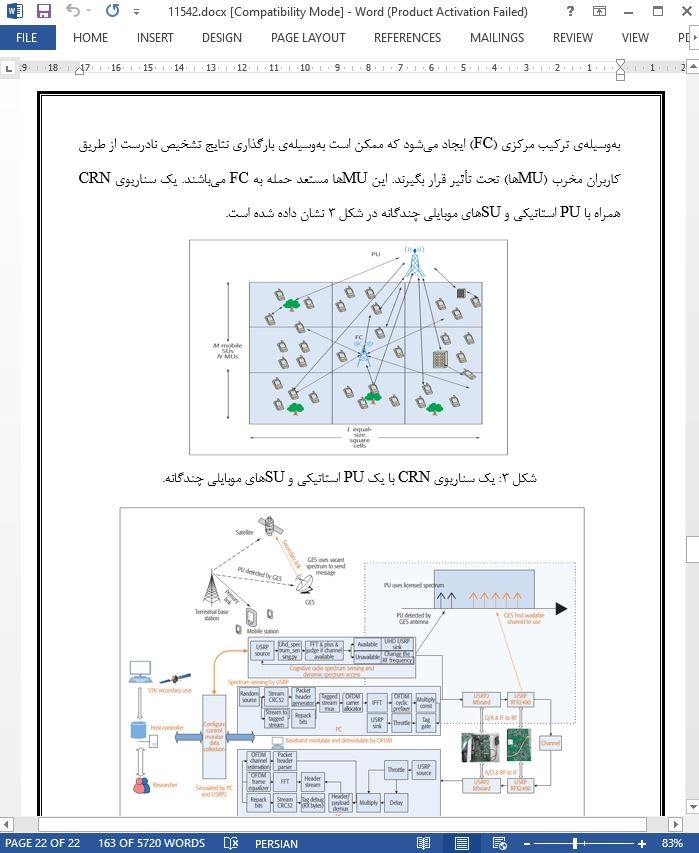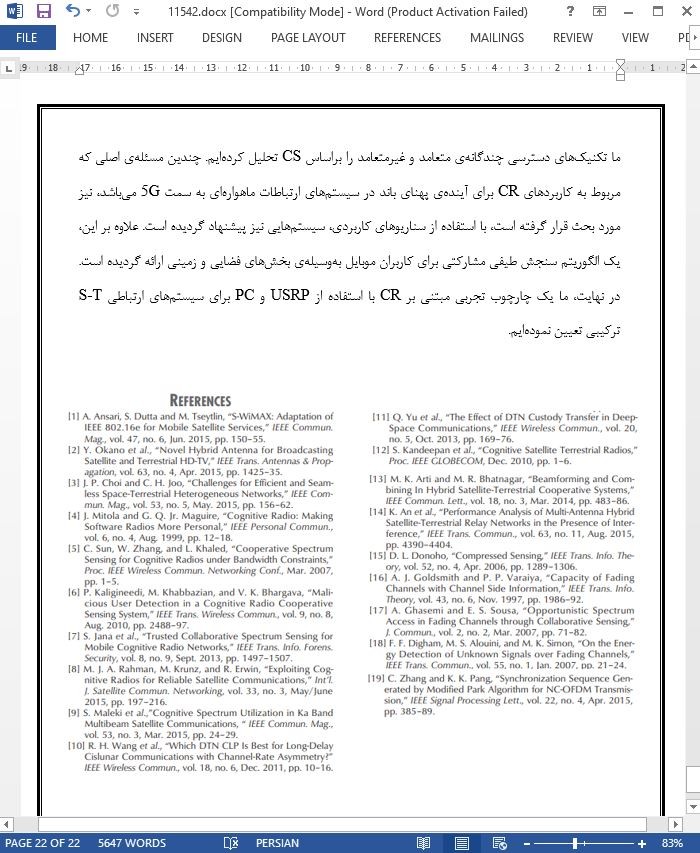
پهنای باند ترکیبی سیستم های ارتباطی ماهواره ای- زمینی براساس رادیو شناختی بهسمت 5G
چکیده
توسعهی فنآوری ارتباطات موبایل زمینی 5G یک نیروی تحریککننده برای ایجاد انقلاب در ارتباطات موبایل ماهوارهای فراهم کرده است. ارتباطات موبایل ماهوارهای دارای ویژگیهای منحصربهفرد زیادی میباشد از جمله دارای پوشش عالی میباشد و از ارتباطات اضطراری قابل اعتماد پشتیبانی میکند، بایستی الزامات برای همگرایی بین ارتباطات موبایل زمینی و ارتباطات موبایل ماهوارهای برای آیندهی پهنای باند ترکیبی ارتباطات S-T برآورده شود. از سویی دیگر، CR یک تکنیک جالب جهت پشتیبانی از دسترسی دینامیکی تککاربری و چندکاربری در ارتباطات S-T ترکیبی میباشد. ابتدا در این پژوهش، چندین موضوع اصلی در اعمال کردن رادیو شناختی برای آیندهی پهنای باند ارتباطات ماهوارهی به سمت 5G مورد بحث قرار میگیرد. سپس ما یک بررسی اجمالی بر روی آیندهی پهنای باند ترکیبی سیستمهای ارتباطات S-T ارائه میدهیم که این کار با استفاده از تعریف یک سناریوی کاربردی نمونه در آیندهی پهنای باند CR ترکیبی در سیستمهای ارتباطی S-T به سمت 5G انجام میپذیرد. علاوه بر این، ما یک طراحی بخش فضایی براساس یک چارچوب مشارکتی مبتنی بر حسگری طیف با در نظر گرفتن وجود MUها ارائه میدهیم. همچنین یک چارچوب تجربی برای سیستم ارتباطات S-T ترکیبی مبتنی بر CR ارائه و شرح داده شده است.
مقدمه
فنآوری ارتباطات موبایل زمینی در 20 سال گذشته یک رشد سریع را تجربه کرده است. در این دههها، ارتباطات موبایل زمینی از طریق نسل اول (1G) که یک سیستم آنالوگ بود به 4G تکامل یافته است که از ارتباطات پهنای باند موبایل پشتیبانی مینماید. اخیرا سیستمهای 4G بهصورت گسترده توسط اپراتورهای مخابراتی در سراسر دنیا مورد استفاده قرار گرفتهاند. در حال حاضر، تلاشهایی برای برنامهریزی و استاندارد کردن سیستمهای موبایل 5G در حال انجام است. پروژه مشارکتی نسل سوم (3GPP)، IEEE، مخابرات موبایل بینالمللی (IMT) و بسیاری بخشهای استانداردسازی دیگر با تولیدکنندگان و اپراتورهای مخابراتی در حال کار و تلاش هستند تا بتوانند سیستمهای ارتباطات موبایل 5G را استانداردسازی کنند.
نتیجهگیری
پهنای باند ترکیبی سیستمهای ارتباطات S-T که متشکل از بخشهای فضایی و زمینی میباشد، میتواند الزامات تعداد زیادی از کاربران با خدمات متنوع در آیندهی شبکههای 5G را برآورده سازد. در این پژوهش، ما یک مرور کلی بر روی اساس آیندهی پهنای باند ترکیبی در سیستمهای ارتباطات S-T با استفاده از سه ماهوارهی GEO را ارائه دادیم و یک ساختار سلسله مراتبی را بهوسیلهی شبکهی فضایی براساس تجربیات موجود در چین پیشنهاد نمودیم. ما تکنیکهای دسترسی چندگانهی متعامد و غیرمتعامد را براساس CS تحلیل کردهایم. چندین مسئلهی اصلی که مربوط به کاربردهای CR برای آیندهی پهنای باند در سیستمهای ارتباطات ماهوارهای به سمت 5G میباشد، نیز مورد بحث قرار گرفته است، با استفاده از سناریوهای کاربردی، سیستمهایی نیز پیشنهاد گردیده است. علاوه بر این، یک الگوریتم سنجش طیفی مشارکتی برای کاربران موبایل بهوسیلهی بخشهای فضایی و زمینی ارائه گردیده است. در نهایت، ما یک چارچوب تجربی مبتنی بر CR با استفاده از USRP و PC برای سیستمهای ارتباطی S-T ترکیبی تعیین نمودهایم.
Abstract
The development of 5G terrestrial mobile communications technology has been a driving force for revolutionizing satellite mobile communications. Satellite mobile communications, which carry many unique features, such as large coverage and support for reliable emergency communications, should satisfy the requirements for convergence between terrestrial mobile communications and satellite mobile communications for future broadband hybrid S-T communications. On the other hand, CR is an attractive technique to support dynamic single-user or multi-user access in hybrid S-T communications. This article first discusses several key issues in applying cognitive radio to future broadband satellite communications toward 5G. Then we present an overview of future broadband hybrid S-T communications systems, followed by an introduction to a typical application scenario of futuristic CR-broadband hybrid S-T communication systems toward 5G. Moreover, we propose a space segment design based on a spectrum-sensing-based cooperative framework, in consideration of the presence of MUs. An experiment platform for the proposed CR-based hybrid S-T communications system is also demonstrated.
Introduction
Terrestrial mobile communications technology has undergone a rapid growth in the past 20 years. In these decades, modern terrestrial mobile communications have been evolved from the first generation (1G), which is analog systems, to 4G, which supports broadband mobile communications. Currently, 4G systems have been widely deployed by telecommunications operators all over the world. At present, the planning and standardization efforts for 5G mobile systems are underway. The Third Generation Partnership Project (3GPP), IEEE, International Mobile Telecommunications (IMT), and many other standardization bodies are working together with manufacturers and telecom operators in an effort to standardize 5G mobile communications systems. Meanwhile, the International Telecommunication Union (ITU) has started to call for 5G proposals. New proposals need to satisfy the requirements of high spectrum utilization and energy efficiency. The data rate of 5G will also need to be much higher than that of 4G.
Conclusion
Broadband hybrid S-T communications systems composed of terrestrial and space segments can satisfy the requirements of a large number of users with diversified services in future 5G networks. In this article, we present an overview on the fundamentals of future broadband hybrid S-T communications systems using three GEO satellites, and propose a hierarchical structure of the space network based on the experiences in China. We analyze both orthogonal and non-orthogonal multiple access techniques based on CS. Several key issues related to the applications of CR to future broadband satellite communication systems toward 5G are also discussed, along with the application scenarios of the proposed systems. Moreover, we propose a cooperative spectrum sensing algorithm for mobile users of the terrestrial and space segments. Finally, we demonstrate a CR-based experimental platform using USRP and PC for hybrid S-T communication systems.
چکیده
مقدمه
پهنای باند ترکیبی سیستمهای ارتباطات S-T
دسترسی چندگانه و تخصیص منابع در ارتباطات ماهوارهای حاوی باند S و KA
تکنیکهای دسترسی چندگانهی متعامد و غیرمتعامد
پراکندگی و تکنیکهای دسترسی چندگانه
سنجش فشرده و سنجش طیفی مشارکتی در ارتباطات ماهواره
سنجش فشرده
سنجش طیفی مشارکتی
اثبات یک چارچوب تجربی
نتیجهگیری
Abstract
Introduction
Broadband Hybrid S-T Communications Systems
Multiple Access and Resources Allocation at S and Ka Band Satellite Communications
Orthogonal and Non-Orthogonal Multiple Access Techniques
Sparsity and Multiple Access Techniques
Compressive Sensing and Cooperative Spectrum Sensing in Satellite Communications
Compressive Sensing
Cooperative Spectrum Sensing
Demonstration of an Experimental Platform
Conclusion
- اصل مقاله انگلیسی با فرمت ورد (word) با قابلیت ویرایش
- ترجمه فارسی مقاله با فرمت ورد (word) با قابلیت ویرایش، بدون آرم سایت ای ترجمه
- ترجمه فارسی مقاله با فرمت pdf، بدون آرم سایت ای ترجمه



